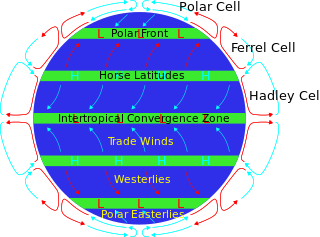
In meteorology, a cyclone is a large scale air mass that rotates around a strong center of low atmospheric pressure. Cyclones are characterized by inward spiraling winds that rotate about a zone of low pressure. The largest low-pressure systems are polar vortices and extratropical cyclones of the largest scale. Warm-core cyclones such as tropical cyclones and subtropical cyclones also lie within the synoptic scale. Mesocyclones, tornadoes and dust devils lie within smaller mesoscale. Upper level cyclones can exist without the presence of a surface low, and can pinch off from the base of the tropical upper tropospheric trough during the summer months in the Northern Hemisphere. Cyclones have also been seen on extraterrestrial planets, such as Mars and Neptune. Cyclogenesis is the process of cyclone formation and intensification. Extratropical cyclones begin as waves in large regions of enhanced mid-latitude temperature contrasts called baroclinic zones. These zones contract and form weather fronts as the cyclonic circulation closes and intensifies. Later in their life cycle, extratropical cyclones occlude as cold air masses undercut the warmer air and become cold core systems. A cyclone's track is guided over the course of its 2 to 6 day life cycle by the steering flow of the subtropical jet stream.
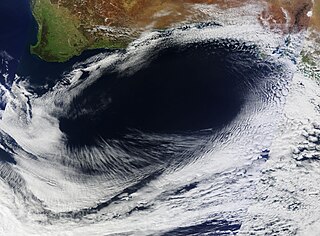
An anticyclone is a weather phenomenon defined by the United States National Weather Service's glossary as "a large-scale circulation of winds around a central region of high atmospheric pressure, clockwise in the Northern Hemisphere, counterclockwise in the Southern Hemisphere". Effects of surface-based anticyclones include clearing skies as well as cooler, drier air. Fog can also form overnight within a region of higher pressure. Mid-tropospheric systems, such as the subtropical ridge, deflect tropical cyclones around their periphery and cause a temperature inversion inhibiting free convection near their center, building up surface-based haze under their base. Anticyclones aloft can form within warm core lows such as tropical cyclones, due to descending cool air from the backside of upper troughs such as polar highs, or from large scale sinking such as the subtropical ridge. The evolution of an anticyclone depends on a few variables such as its size, intensity, moist-convection, Coriolis force etc.

The Roaring Forties are strong westerly winds found in the Southern Hemisphere, generally between the latitudes of 40 and 50 degrees. The strong west-to-east air currents are caused by the combination of air being displaced from the Equator towards the South Pole, the Earth's rotation, and the scarcity of landmasses to serve as windbreaks.
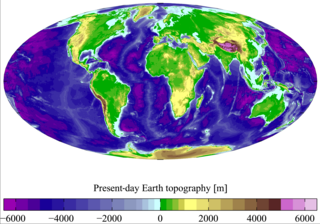
Physical oceanography is the study of physical conditions and physical processes within the ocean, especially the motions and physical properties of ocean waters.

A nor'easter is a macro-scale extratropical cyclone in the western North Atlantic ocean. The name derives from the direction of the strongest winds that will be hitting an eastern seaboard of the northern hemisphere: as a cyclonic air mass rotates counterclockwise, winds tend to blow northeast-to-southwest over the region covered by the northwest quadrant of the cyclone. Use of the term in North America is associated with storms that impact the middle and north Atlantic areas of the United States, and in the Atlantic Provinces of Canada.

The Intertropical Convergence Zone (ITCZ), known by sailors as the doldrums or the calms, is the area encircling Earth near the Equator, where the northeast and southeast trade winds converge.
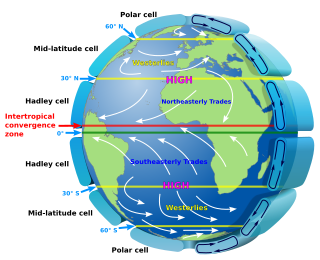
Atmospheric circulation is the large-scale movement of air, and together with ocean circulation is the means by which thermal energy is redistributed on the surface of the Earth.

A high-pressure area, high or anticyclone is a region where the atmospheric pressure at the surface of the planet is greater than its surrounding environment.

The westerlies, anti-trades, or prevailing westerlies, are prevailing winds from the west toward the east in the middle latitudes between 30 and 60 degrees latitude. They originate from the high-pressure areas in the horse latitudes and trend towards the poles and steer extratropical cyclones in this general manner. Tropical cyclones which cross the subtropical ridge axis into the westerlies recurve due to the increased westerly flow. The winds are predominantly from the southwest in the Northern Hemisphere and from the northwest in the Southern Hemisphere.
A Kelvin wave is a wave in the ocean or atmosphere that balances the Earth's Coriolis force against a topographic boundary such as a coastline, or a waveguide such as the equator. A feature of a Kelvin wave is that it is non-dispersive, i.e., the phase speed of the wave crests is equal to the group speed of the wave energy for all frequencies. This means that it retains its shape as it moves in the alongshore direction over time.

A trough is an elongated (extended) region of relatively low atmospheric pressure, often associated with fronts. Troughs may be at the surface, or aloft, or both under various conditions. Most troughs bring clouds, showers, and a wind shift, particularly following the passage of the trough. This results from convergence or "squeezing" which forces lifting of moist air behind the trough line.
Horse Latitudes is tenth collection of poetry from the Northern Irish poet Paul Muldoon. It was published by Faber and Faber on 19 October 2006. It consists of 19 sonnets, each named for a battle beginning with the letter B.
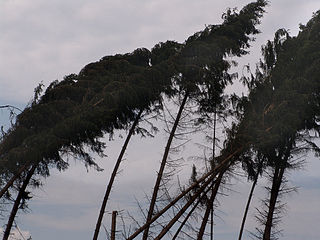
Wind is the flow of gases on a large scale. On the surface of the Earth, wind consists of the bulk movement of air. In outer space, solar wind is the movement of gases or charged particles from the Sun through space, while planetary wind is the outgassing of light chemical elements from a planet's atmosphere into space. Winds are commonly classified by their spatial scale, their speed, the types of forces that cause them, the regions in which they occur, and their effect. The strongest observed winds on a planet in the Solar System occur on Neptune and Saturn. Winds have various aspects, an important one being its velocity ; another the density of the gas involved; another its energy content or wind energy. Wind is also a great source of transportation for seeds and small birds; with time things can travel thousands of miles in the wind.
Rossby-gravity waves are equatorially trapped waves, meaning that they rapidly decay as their distance increases away from the equator. These waves have the same trapping scale as Kelvin waves, more commonly known as the equatorial Rossby deformation radius. They always carry energy eastward, but their 'crests' and 'troughs' may propagate westward if their periods are long enough.

John Gilpin was an 1852 clipper in the California trade, named after the literary character John Gilpin. The ship was known for its 1852 race against the clipper Flying Fish, and for its collision with an iceberg.
There are a number of explanations of the asymmetry of the Intertropical Convergence Zone (ITCZ), known by sailors as The Doldrums.
The length of the day, which has increased over the long term of Earth's history due to tidal effects, is also subject to fluctuations on a shorter scale of time. Exact measurements of time by atomic clocks and satellite laser ranging have revealed that the length of day (LOD) is subject to a number of different changes. These subtle variations have periods that range from a few weeks to a few years. They are attributed to interactions between the dynamic atmosphere and Earth itself. The International Earth Rotation and Reference Systems Service monitors the changes.
Centers of action are extensive and almost stationary low-pressure areas or anticyclones which control the movement of atmospheric disturbances over a large area. This does not mean that the position of the center is constant over a specific area but that the monthly atmospheric pressure corresponds to a high or a low pressure.




